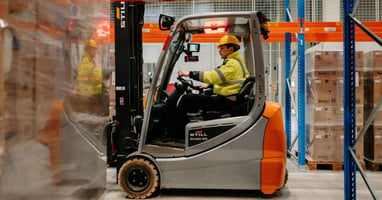Loading docks are one of the busiest and most dynamic areas in any facility. With so much activity...
The Top 6 Ways To Increase Loading Dock Efficiency

The loading dock is the heart of any warehouse operation since it's where you receive, store, and ship goods. Inefficiencies here can ripple through the entire supply chain, causing delays and increasing costs. By focusing on the best ways to increase loading dock efficiency, businesses can streamline their operations and gain a competitive edge.
Streamline Processes for Faster Turnaround
One of the top ways to increase dock efficiency is to streamline processes. This involves evaluating current workflows and identifying bottlenecks.
Consider implementing standardized procedures for loading and unloading. This ensures that everyone knows their role and can perform tasks quickly and efficiently.
Implementing Standard Operating Procedures (SOPs)
Standard operating procedures (SOPs) are essential for consistency and efficiency. SOPs provide clear guidelines for every task, reducing confusion and errors. Regularly review and update these procedures to reflect best practices and new technologies.
Training and Development Programs
Investing in training and development programs for dock workers can pay off significantly. Training ensures that employees are familiar with SOPs and can operate equipment safely and efficiently. Continuous development programs keep skills sharp and introduce new techniques and technologies.
Utilizing Technology for Process Improvement
Technology can play a crucial role in streamlining processes. Consider using warehouse management systems (WMS) to track inventory and manage workflows. Automated systems can reduce manual tasks, freeing up workers for more complex activities.
Optimize Dock Layout for Maximum Efficiency

The layout of your loading dock can have a significant impact on efficiency. An optimized dock layout minimizes movement and reduces the time taken to load and unload goods.
Designing an Efficient Dock Layout
Design your dock layout with efficiency in mind. Position loading bays close to storage areas to minimize travel time.
Ensure there is enough space for forklifts and other equipment to maneuver easily. Use color-coded zones to organize different types of goods and streamline workflows.
Utilizing Dock Levelers and Seals
Dock levelers and seals can improve safety and efficiency. Levelers bridge the gap between the dock and the truck, allowing for smooth loading and unloading. Seals prevent energy loss and protect goods from the elements, ensuring they remain in good condition.
Investing in High-Quality Equipment
High-quality equipment can make a significant difference in dock operations. Invest in durable and reliable forklifts, pallet jacks, and conveyor systems. Regular maintenance ensures equipment operates at peak efficiency, reducing downtime, and repair costs.
Enhance Communication and Coordination
Effective communication and coordination are vital for efficient dock operations. Ensure that all team members are on the same page and can communicate easily.
Implementing Communication Systems
Implement communication systems such as radios or intercoms to facilitate quick and easy communication. These systems allow workers to relay information instantly, reducing delays and improving coordination.
Scheduling and Planning
Proper scheduling and planning can prevent bottlenecks and ensure a smooth workflow. Use scheduling software to plan loading and unloading times, considering factors such as peak hours and truck arrival times. Regularly review schedules and adjust as needed to maintain efficiency.
Fostering Team Collaboration
Encourage collaboration among team members. Regular team meetings can help identify issues and brainstorm solutions. A collaborative environment fosters a sense of ownership and accountability, leading to more efficient operations.
Prioritize Safety for Smooth Operations

Safety is key in loading dock operations. Ensuring a safe working environment can prevent accidents and injuries, reducing downtime, and associated costs.
Implementing Safety Protocols
Develop and enforce safety protocols for all dock activities. This includes proper lifting techniques, use of personal protective equipment (PPE), and safe operation of machinery. Regular safety audits can identify potential hazards and ensure compliance with safety standards.
Training and Awareness Programs
Conduct regular safety training sessions for all employees. Training should cover the proper use of equipment, emergency procedures, and hazard identification. Safety awareness programs can reinforce the importance of safety and encourage a safety-first culture.
Utilizing Logimate’s Warehouse Safety Solutions
Invest in warehouse safety products from Logimate to protect workers and equipment. This includes dock laser solutions, Lopos smart proximity detectors, laser walkways, crane hazard solutions, projection walkways, and forklift safety solutions. Proper LED lighting and virtual signage can also enhance safety by improving visibility and guiding workers.
Leverage Data for Continuous Improvement
Data-driven decision-making can lead to continuous improvement in dock operations. Collecting and analyzing data can identify areas for improvement and track progress over time.
Implementing Data Collection Systems
Use data collection systems such as sensors and tracking software to monitor dock activities. These systems can provide real-time data on factors such as loading times, equipment usage, and inventory levels.
Analyzing Data for Insights
Regularly analyze data to gain insights into dock operations. Look for trends and patterns that indicate inefficiencies or areas for improvement. Use this information to make informed decisions and implement targeted improvements.
Setting Key Performance Indicators (KPIs)
Establish key performance indicators (KPIs) to measure the efficiency of dock operations. KPIs can include metrics such as loading times, error rates, and equipment downtime. Regularly review these metrics to track progress and identify areas for further improvement.
Foster a Culture of Continuous Improvement
Creating a culture of continuous improvement can drive long-term efficiency gains. Encourage employees to identify and suggest improvements and involve them in the decision-making process.
Encouraging Employee Feedback
Create channels for employees to provide feedback on dock operations. This can include suggestion boxes, regular surveys, and team meetings. Act on feedback to show you value employees that their input and can lead to positive changes.
Celebrating Successes
Celebrate successes and milestones in dock operations. Recognizing and rewarding employees for their contributions can boost morale and encourage a culture of continuous improvement.
Implementing Improvement Programs
Implement programs such as Kaizen or Lean to drive continuous improvement. These programs focus on small, incremental changes that can lead to significant efficiency gains over time. Involve employees in these programs to foster a sense of ownership and accountability.
Boosting loading dock efficiency is a critical aspect of many industries and can have a profound impact on overall operations. A well-optimized loading dock will also significantly enhance productivity, reduce costs, and improve overall operational efficiency.
For more insights and personalized recommendations, consider consulting with Logimate today! Our experience and knowledge can provide valuable guidance for optimizing your dock operations.




